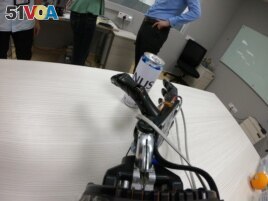14 July 2021
Researchers in Singapore have developed an electronic material that helps robots sense touch and nearby objects.
The material is a kind of foam: a solid substance that is filled with air and is soft. And the foam has another useful quality. It repairs itself when damaged, much like human skin.
The material is called AiFoam, which is short for artificially innervated foam. To innervate means to supply with nerves. In robots, AiFoam would gather information from nearby and send it to a computer controlling the robot.
It 'heals' itself
AiFoam is a stretchy polymer combined with a mixture that lowers surface tension. This means that if you cut the material, it can return easily into one piece.
Benjamin Tee is a lead researcher on the new material at the National University of Singapore. He said there are many uses for such a material "especially in robotics and prosthetic devices, where robots need to be a lot more intelligent when working around humans."
To copy the human sense of touch, the researchers mixed microscopic pieces of metal into the material. Then they added very small electrical connections underneath the surface of the foam.

A robotic hand with the AiFoam reaches for a can at National University Singapore's Materials Sciences and Engineering lab in Singapore June 30, 2021.
It senses nearby objects
Tee said that when there is pressure on the material, the metal particles get closer. The movement changes their electrical properties. The electrical connections sense these changes and send information about them to a computer, which then tells the robot what to do.
"When I move my finger near the sensor, you can see the sensor is measuring the changes of my electrical field and responds accordingly to my touch," he said.
The robotic hand senses not only the amount but also the direction of the force placed on it. That could make robots more intelligent and responsive.
Tee said AiFoam is the first material of its kind to combine self-healing properties with nearness and pressure sensing. After spending over two years developing it, Tee and his team hope the material can be put to use within five years.
The material will let "prosthetic users ... have more intuitive use of their robotic arms," he said.
I'm John Russell.
Travis Teo and Lee Ying Shan reported on this story for Reuters. Jill Robbins adapted it for Learning English. Mario Ritter, Jr. was the editor.
__________________________________________________________
Words in This Story
polymer – n. a chemical compound that is made of small molecules that are arranged in a simple repeating structure to form a larger molecule
artificially –adv. not produced in a natural way; manufactured by people
prosthetic – n. an artificial device that replaces a missing or injured part of the body
accordingly – n. in a way that suits the facts, needs, or requirements of a situation
intuitive – adj. easily and quickly learned or understood
What do you think of the new robot technology? We want to hear from you. Write to us in the Comments Section.